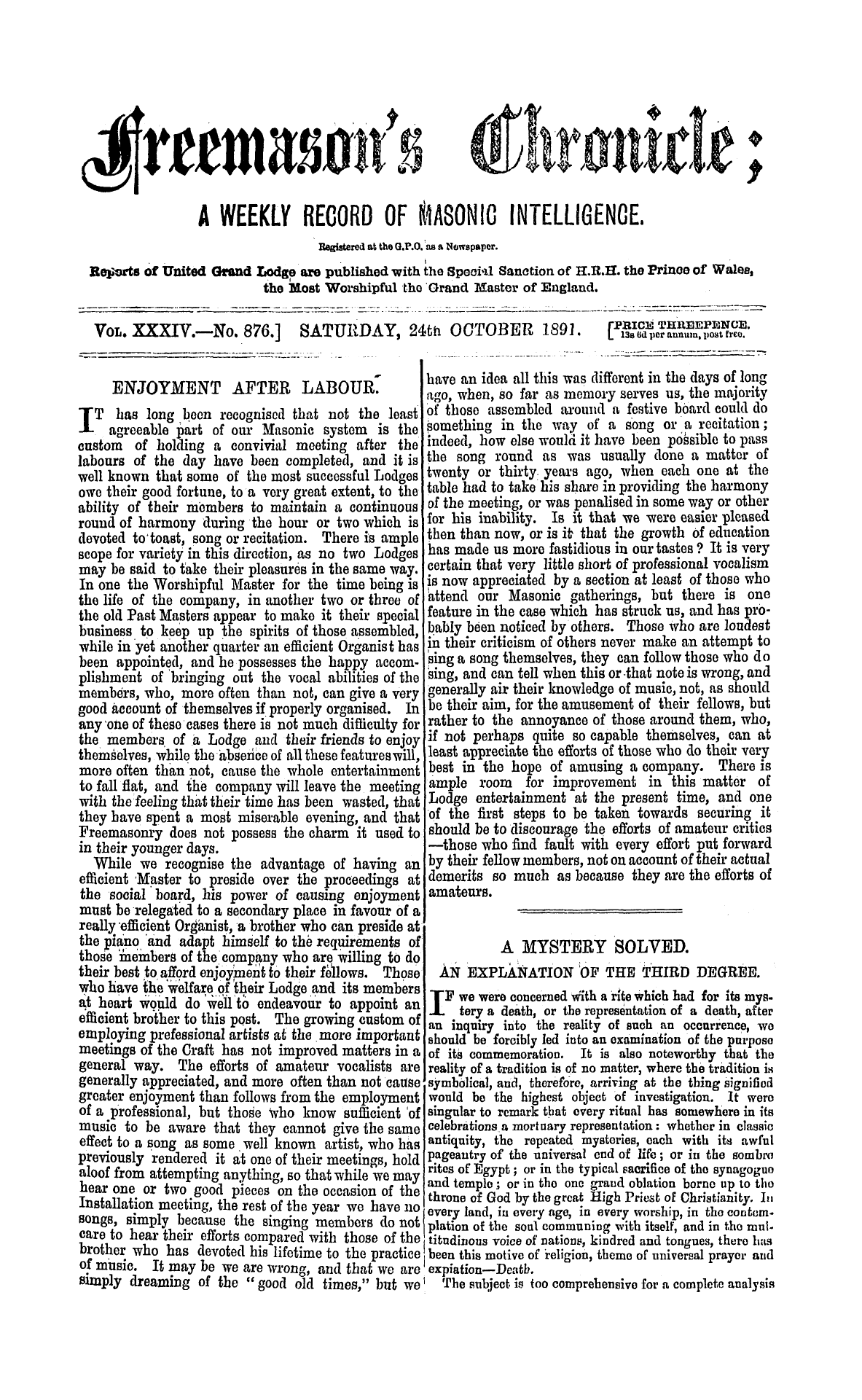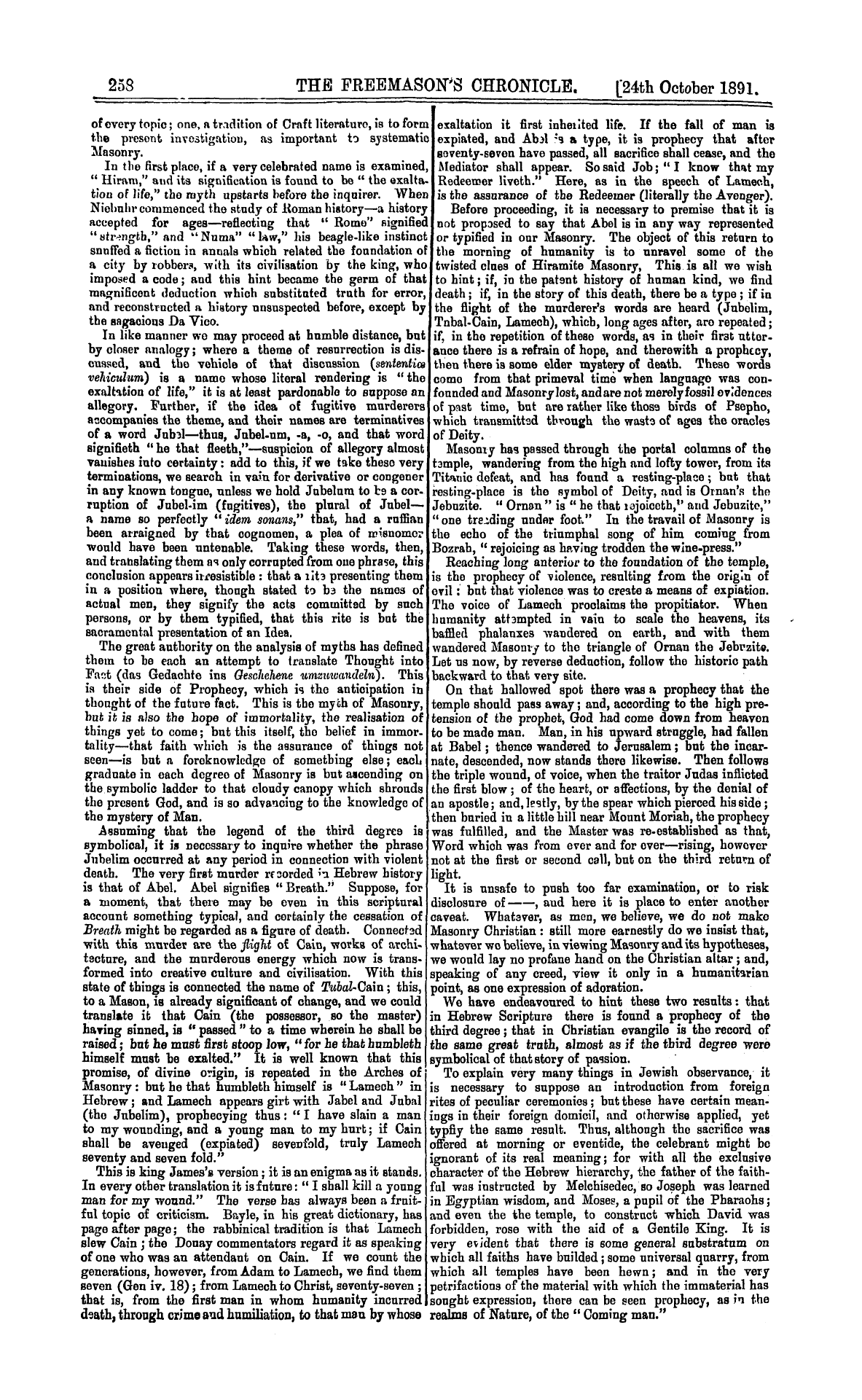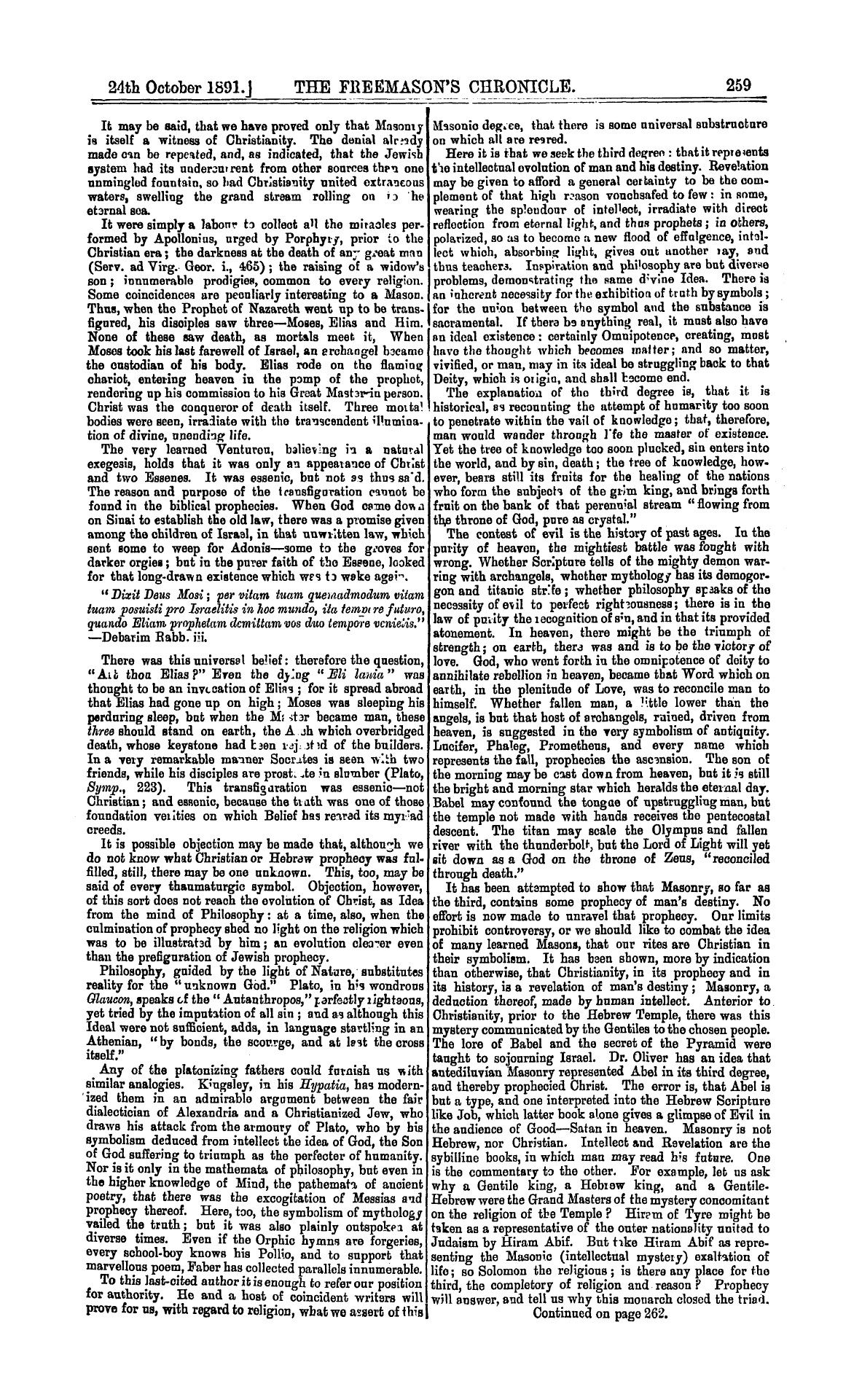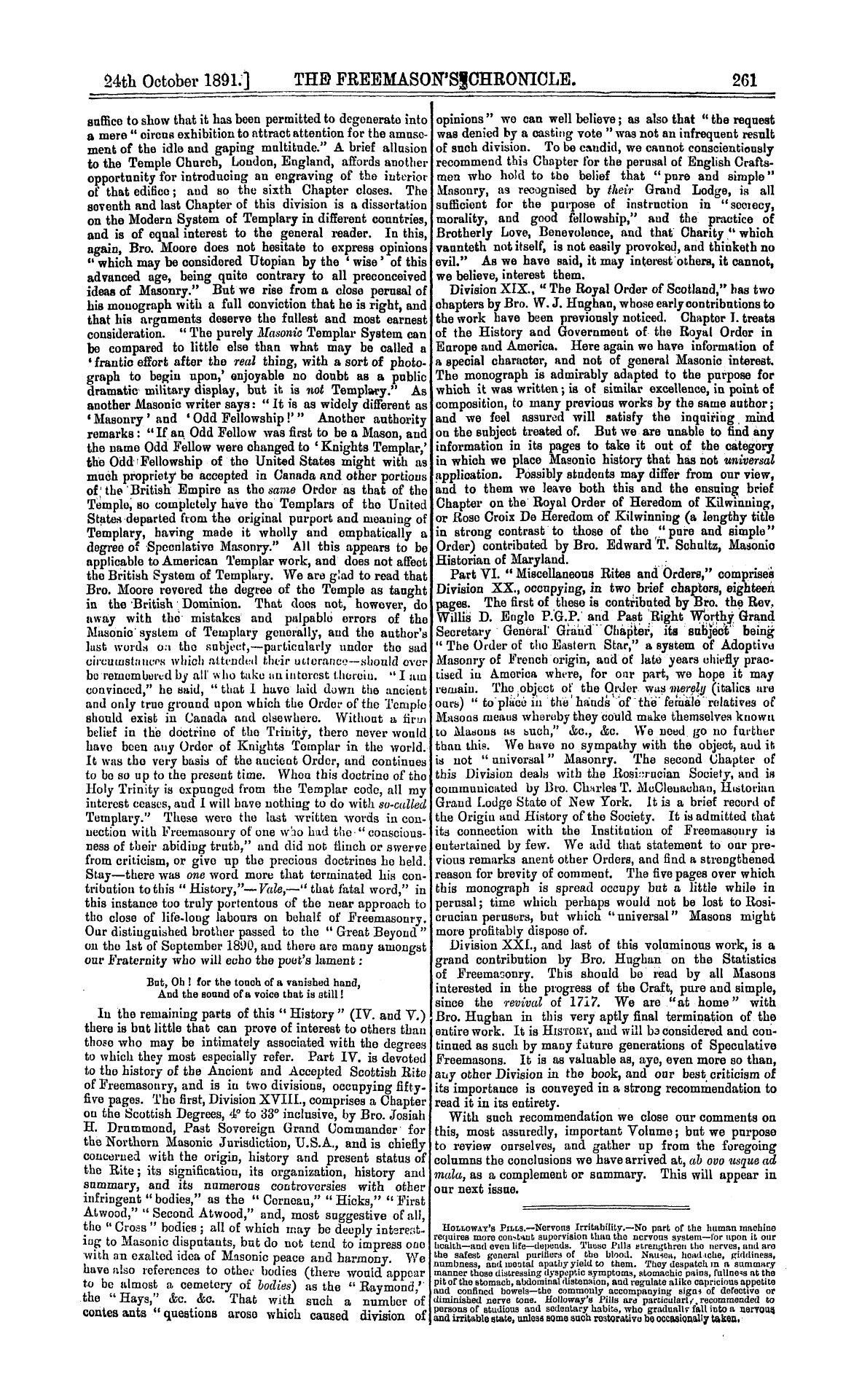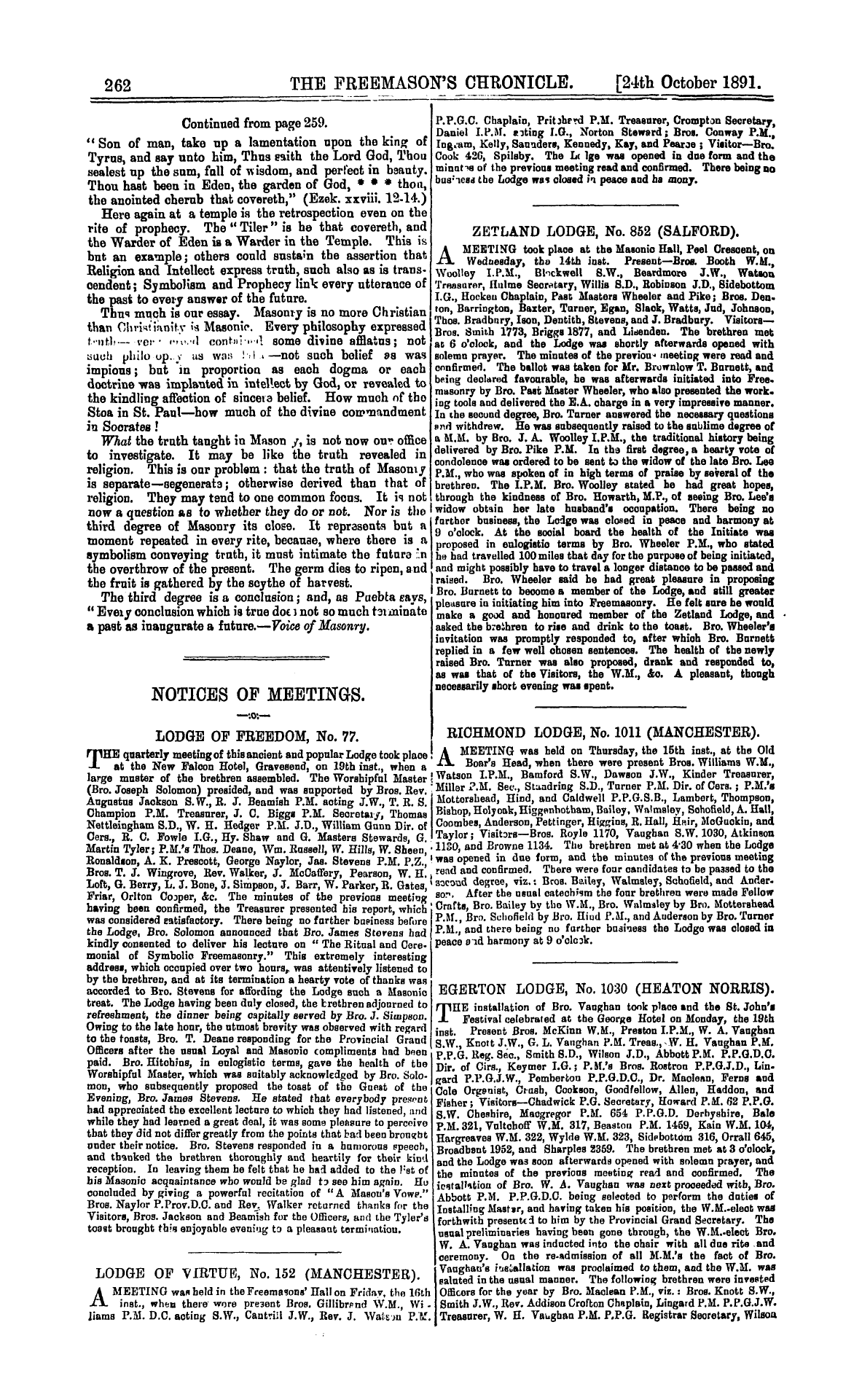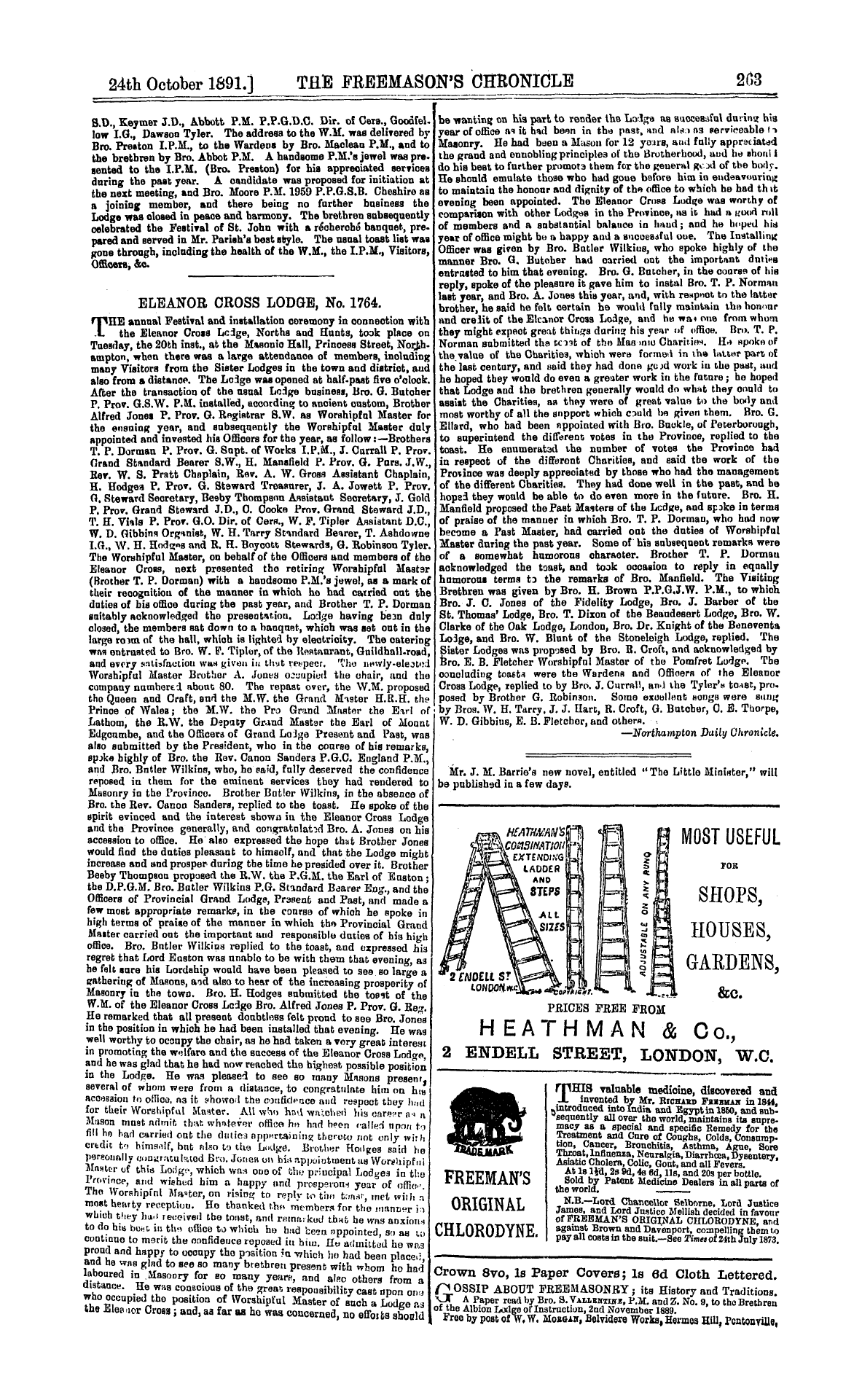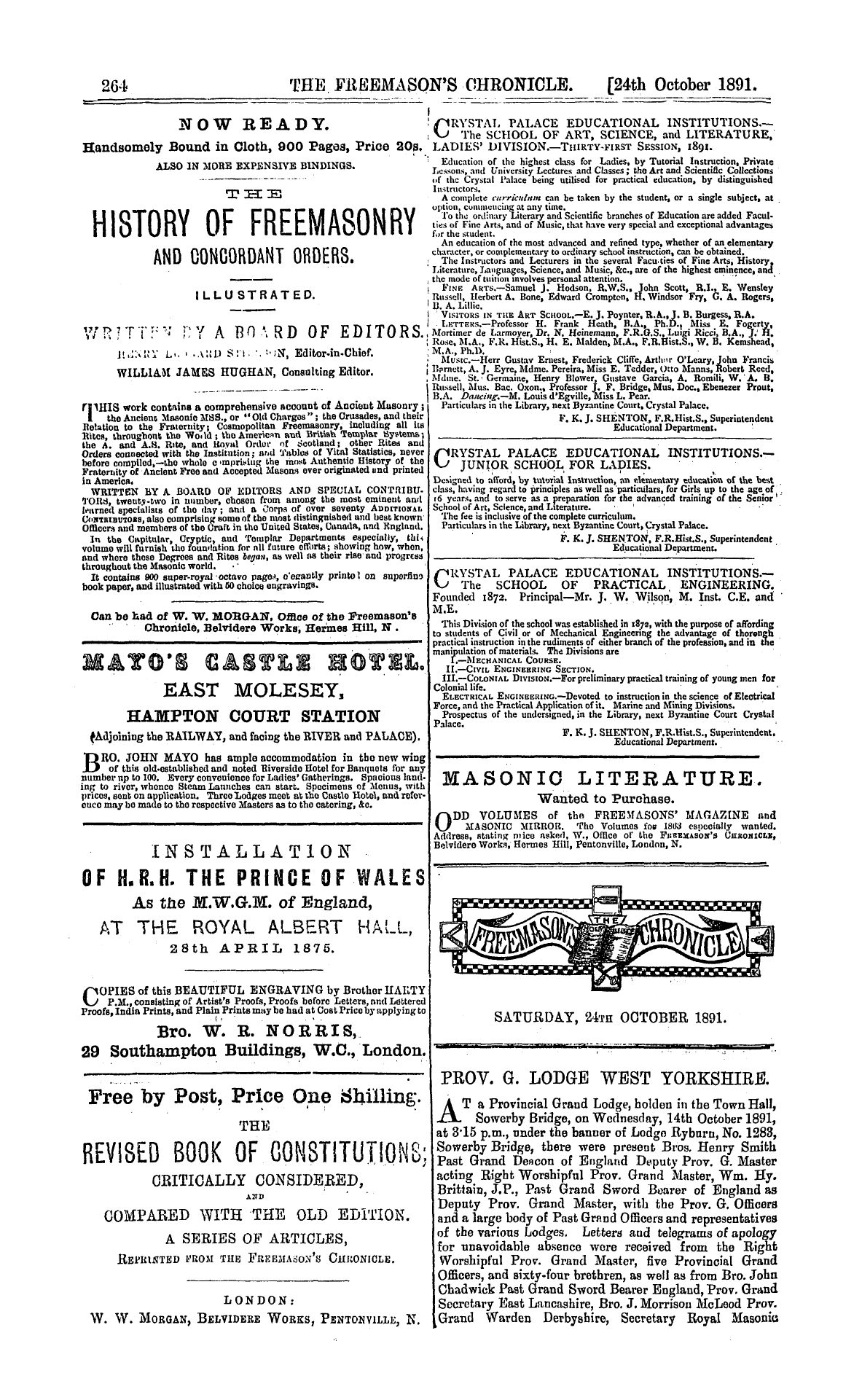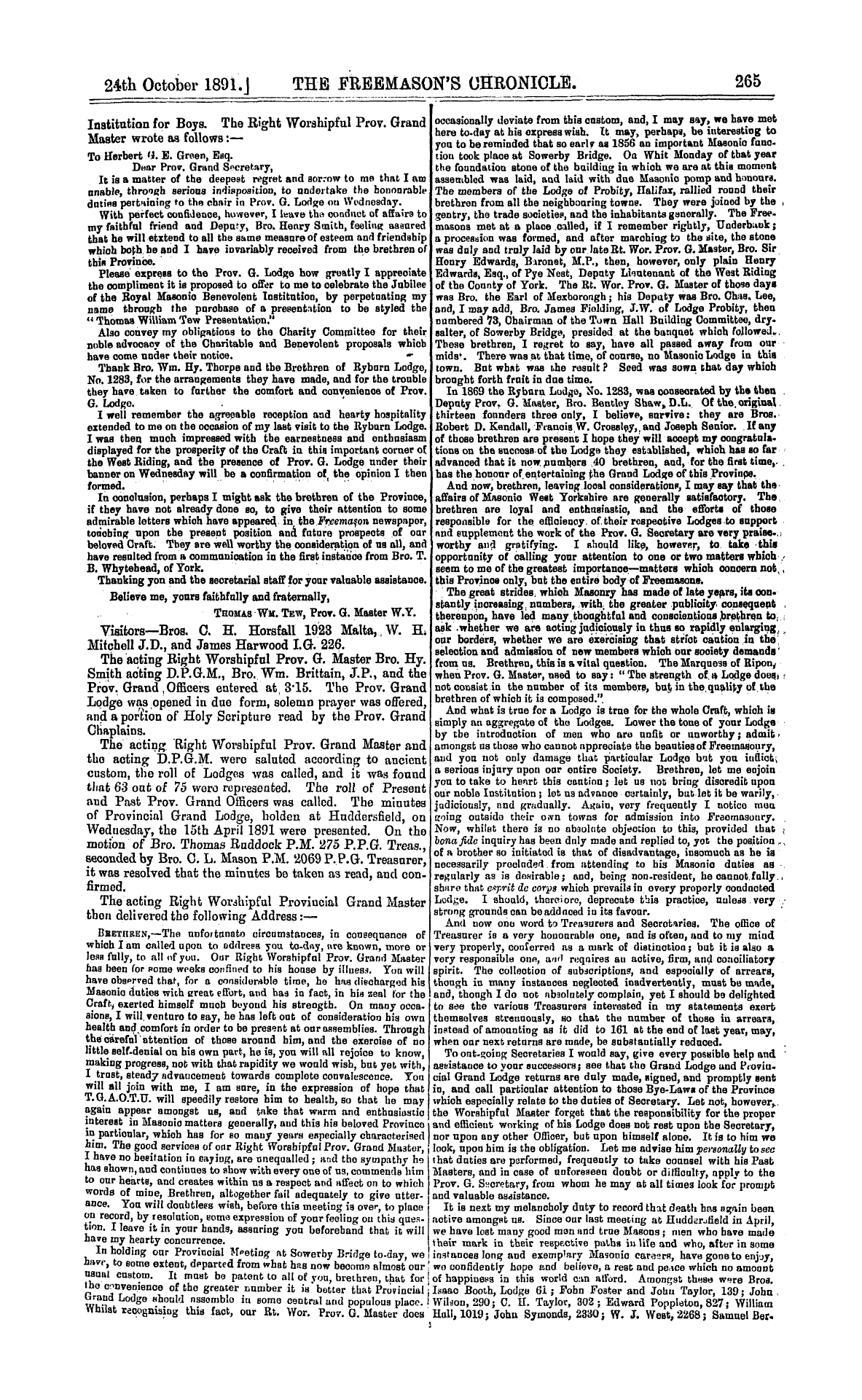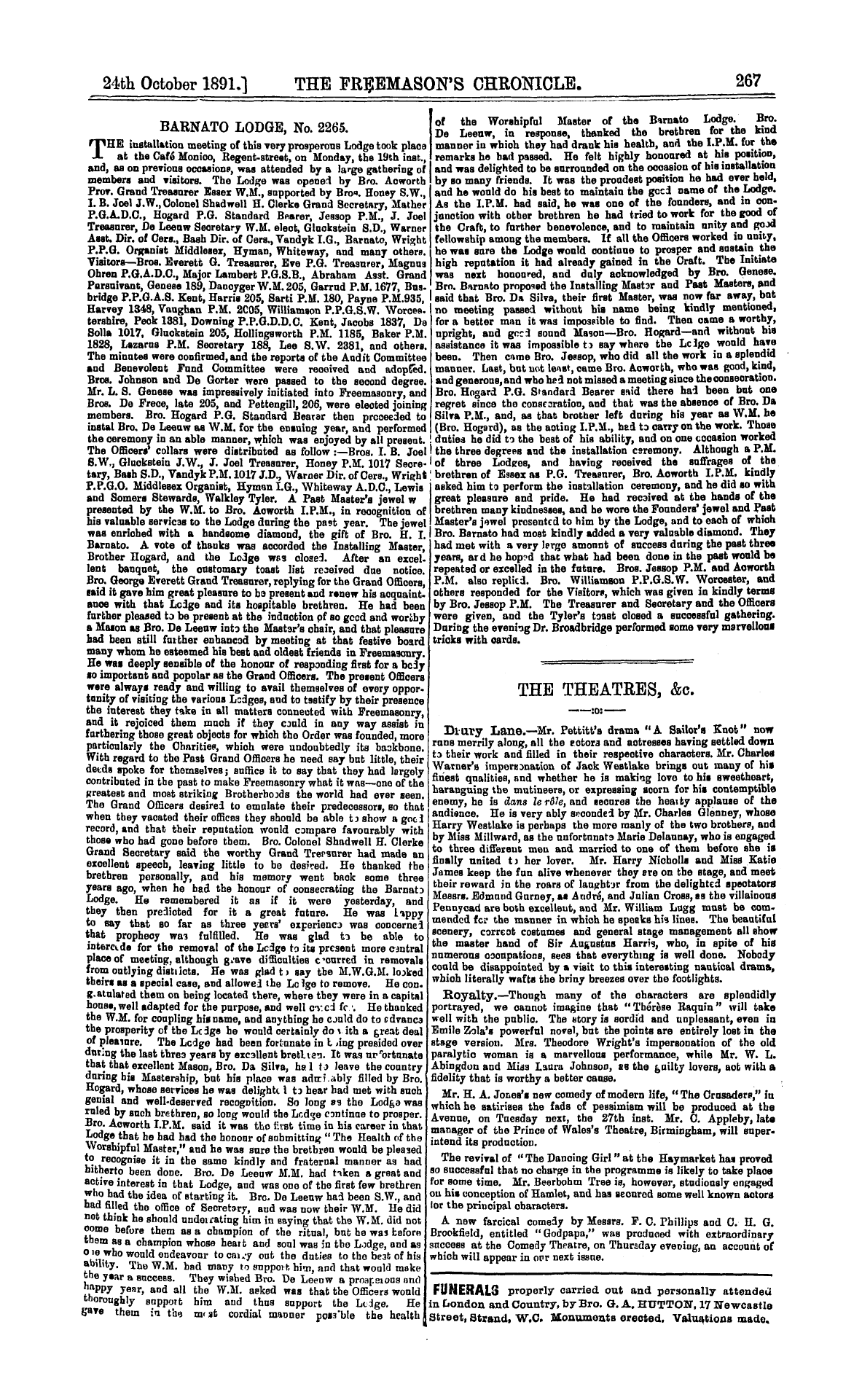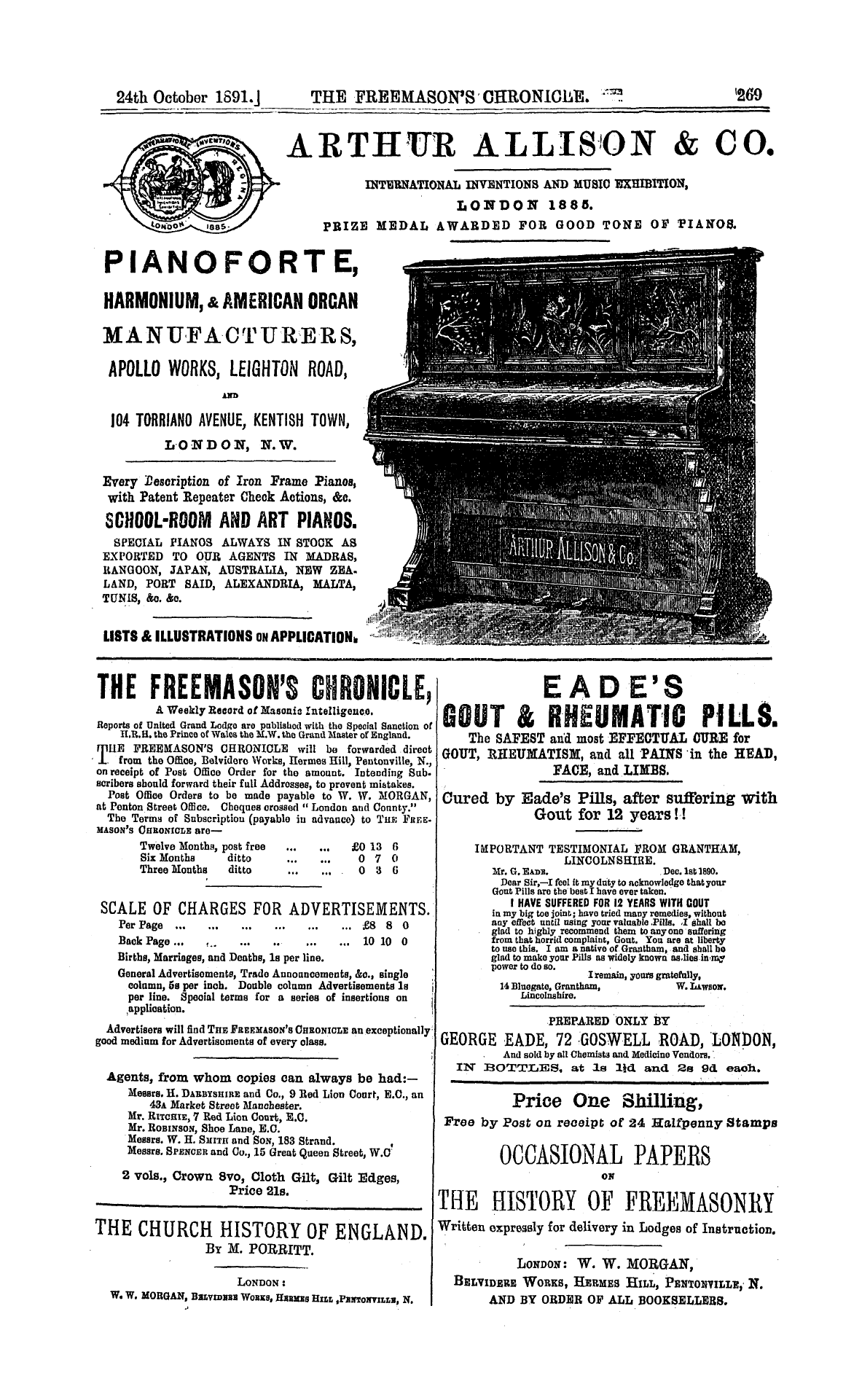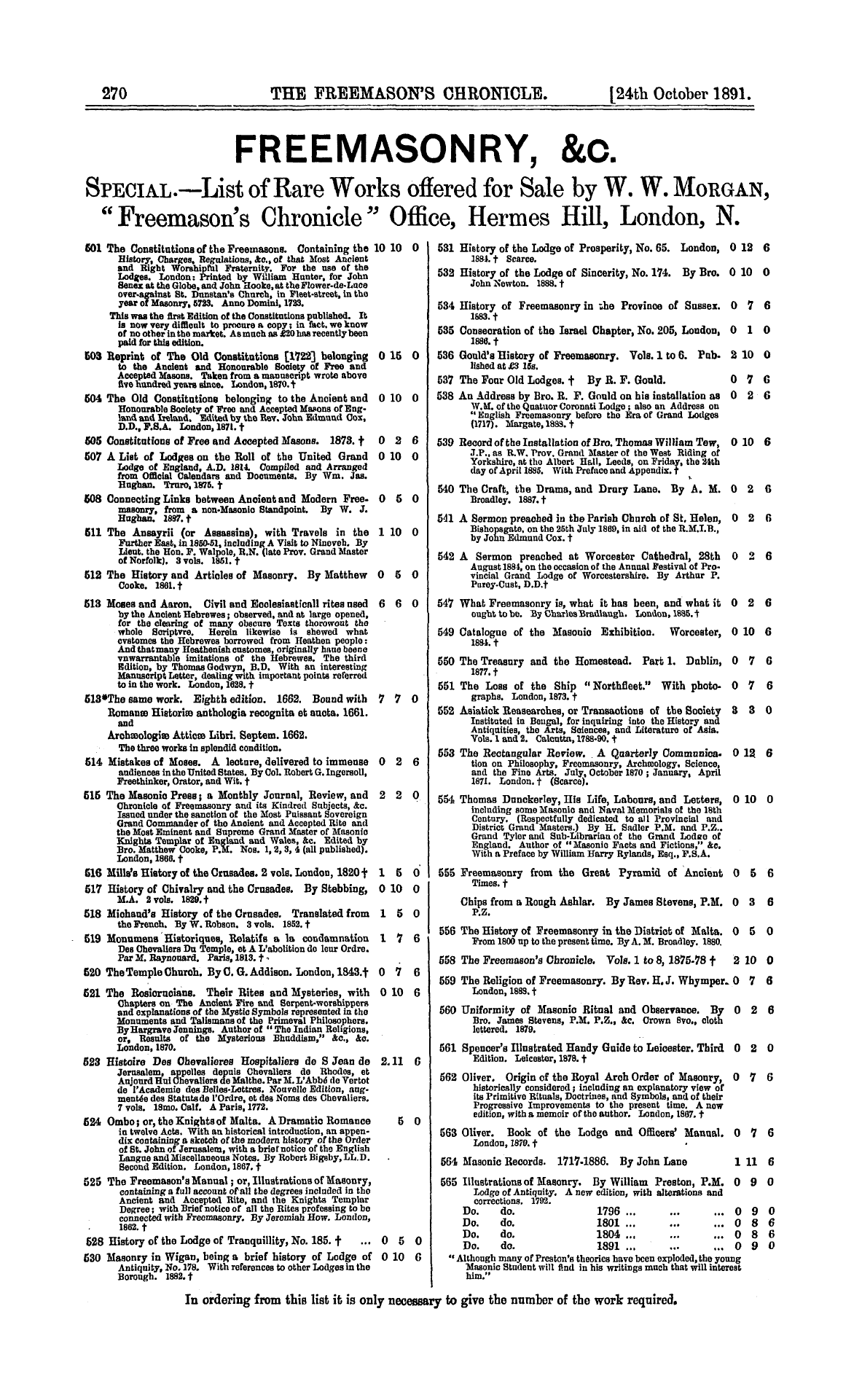-
Articles/Ads
Article A NEW MASONIC HISTORY.* Page 1 of 2 Article A NEW MASONIC HISTORY.* Page 1 of 2 →
Note: This text has been automatically extracted via Optical Character Recognition (OCR) software.
A New Masonic History.*
A NEW MASONIC HISTORY . *
IN the second Chaptor of this Division ( XVII . ) Bi ; o . McLeod Moore continues his monograph , and treats of the Evolution iu tho original plan of Speculative
Freemasonry since the Revival , A . D . 1717-23 , premising thafc " historical investigation clearly demonstrates that in 1717 the present system of degrees was entirely unknown , " a statement which is in strict accord with other reliable
Masonic historians , although distasteful to many who contend for the greater " antiquity " of present ritnal and ceremonial . "In 1721 Dr . Anderson and his colleagues revised the entire work by changing its Christian character to that of Theism , and by the introduction of the ' Hiram
legend into what they called , und is now known as , the ' Third or Masters' degree , ' which came into use A . D 1728-25 . Up to that period Freemasonry was poroly and pointedly Ohriatian . " The history of the period of " secession" 1730-39 ( circa ) is lucidly explained , and the
exposition of its causes is of general interest . About 1740 tho Royal Arch degree first appeared and was generally supposed to have been concocted from thojirst part of tho second section of the " Third or Masters' degree . " Masonic enthusiasts have disputed this , and have endeavoured to
enhance the mystery surrounding Masonry , and its history , by visionary surmises as to its much greater antiquity ; but tbey adduce no evidence of facts which cau bo taken as reasonably conclusive . The " Section" to which Bro . Mooro alludes is , wo presume , that portion of the present
ritnal which We denominate tho "traditional history , " and , to those who are well acquainted with that and also with the R . A . degree , there should not bo much doubt as to the source from which the latter sprang , or as to its being clearly of English origin . Ifc has been called tha fourth
degree m the Masonio System , bat tho Grand Lodge of England acknowledges it as being only tho complement of the " Third or Masters' degree , " and , as such , a part and parcel of " pure and simple " or , as usually termed , " Craft " Masonry . Brethren interested in this qnestion should
make themselves acquainted with farther particulars b y perusal of the wholo of Bro . Moore ' s contribution . The remaining paragraphs in this Chapter relate to the American Rite , tho Union of the English Grand Lodges , the Mark Degree , and the English and American Systems , in all of which wil ] he found special information .
The Third Chapter is a dissertation on " the Masonio High Degrees , " meaning a variety of degrees conferred in different rites professing to bo Masonic , but which cannot in strictness bo considered as properly so , they being only Quasi-Masonic additions made to tho original Craft degrees
of Speculative Freemasonry ; to all above that of Master Mason . Founded upon false premises many of these have been opposed by the English Craffc Lodges as glaring innovations on the true objects and meaning of Speculative
Freemasonry , and the Craft Grand Lodge entirely ignores them ; it simply professes to know them not ! This ia our author ' s text , and his discourse thereon and illustrations connected therewith are such as should sound the knell of
" the greater number of side degrees now practised , with those that come under the category of the high grade system , which are superfluous , and should be struck out altogether from pure Masonry . " He has said it , who was , " ad vitam , " the Supreme Grand Master of Canadian
Knight Templary , stoutly resisting any innovations which might vulgarise his beloved Order , and , contending against all presumptive connection with Freemasonry in origin or constitution , —and we agree with him . Knights Templary as an organization sui generis by all means ; its lessons of
chivalry , charity , bravery , heroism and self sacrifice doubtless inculcate nothing that is not good and beneficial in practice , but it is not and cannot be of universal adoption , and therefore is not pure and simple Masonry . Bro . Moore also calls for the abolition of those ridiculous and empty
titles , to some of which we have already referred , which he characterises as " caricature and burlesque , " and the extinction of which would not take away from whatever
beauty and teaching these " side degrees may possess . A principal objection-to the number of these additional " fancy " degrees is taken on account of the stringent and unnecessary O . B . ' s of secrecy to perpetuate them , when , in
A New Masonic History.*
fact , no secrecy is required ; as , for the mosfc part , they are idle fictions , of no utility . They are merely separate societies , all of whose members are Freemasons . Chapter IV . U " an account of the Religious aud Military Order of tho Knights Templars of the Crusades , and that of Sfc . John of
Jerusalem and Knights of Malta , " in respect of which , as a continuation of the principles and usages of an ancient Order founded in the twelfth centnry ( A . D . 1118-19 ) , for the defence of the Holy Sepulchre , and the protection of Christian pilgrims from Europe visiting the Holy City
to worship afc the sacred shrine , no exception can bo taken , if divested of Masonio association . Bro . Moore , after tracing the origin , objects and progress of this Order from its foundation to its dissolution , but not entire extinguishment , in which Pope Clement V . had so great a part , discusses
the " mistaken connection ofthe Templar Order with Freemasonry , " and finds it difficult to understand how Freemasonry and the Order of the Temple could ever have become amalgamated , for " Symbolic Masonry is , of its very existence , cosmopolitan ; Templary sprang from nn
origin chivalric and knightly . Tho trowel of tho ono levelled distinctions , and spread tho cement of universal fraternity ; the sword and spurs of the other could only bo obtained and worn by men of noble birth , or those famed for heroic deeds in defence of tho Christian faith . " In
Chaptor V . the author continues the snbjocfc under tho heading of " Commencement of Afodeqn or Masonio Templary . " Herein ho shows under what conditions u revival of tho obsolete chivalric Orders took place iu the lasfc century under the mistaken supposition that they wero
of Masonio origin . " " Tho military Templars and the ancient builders , —Stone-masons of the Cloisters—with trowel in hand and sword by their side , took their rise from tho same source , promulgating the same doctrines of the sacred mysteries . This may have helped to originate the error
of a subsequent connection with Freemasonry , bufc Templary founded upon Modern Freemasonry is a misnomer , and does not represent tho Templar Order , ancient or modern . It is only an imitation Masonio degree , on Christian principles , imposing on the careless crowd , with
whom ceremonial and show too often usurps the place of truth , which they thus sacrifice to the love of popularity and display , His words again , not ours . Sis decided opinions , and ours . Wo have but lightly skimmed the
surface of the deep research contained in this and the foregoing chapters , and only in such portions as might chiefly interest brethren of the Craft degrees who are not fratres of tho Temple . For the consideration of those who are , we append the following final paragraph of this Chapter : —
" It seema strange that it has never occurred to those who are so anxions to impart to Masonic Templary a dramatic military appearance , what an extraordinary phase the Order has assumed by tho adoption of a system of military drills , & c , as practised in the American system . Have
they forgotten that the Ancient Templars were meu of rank and position , and not the equivalent of a volunteer militia battalion ? No doubt in the early days of the Order the Knights fought as a body of fighting men , without regard to tho details of military organization ; bufc when
the Order became more numerous and powerful , and when military formations prevailed , the Templars retained a body of ' men at arms , ' and the Knights occupied all superior
positions as leaders . We have an actual experience of this in the Order of St . John of Jerusalem , Malta , where tbe Knights not only maintained an army of land forces , but also a navy . "
We find ourselves devoting more space and attention to this section of the entire "History" than we had intended , bnt the subject matter is of great interest to a vast number of both Fraternities , and Brother Moore ' s discussion is fascinating in the highest degree . A bold outspoken
expression of opinions pervades this monograph throughout , and the attentive reader feels assured that he is being told the truth , without bias , favonr , or affection . Our further comments must , however , be brief . In Chapter VI ., the changes made consequent upon the reformed Ritual of
Convent General , are discussed , the Derivation of the ritual of that body and its details explained , and its " Crosses " described . " Tho Landmarks of the Order " ia a subject of comment , and , and as an exposition , to some
extent , of the " symbolism " of Knight Templary the entire chapter is interesting . We need nofc reproduce here the further animadversions of the author upon the " Modern " Templary which does not represent the Ancient Religious and Military Order ; what we have already quoted will
Note: This text has been automatically extracted via Optical Character Recognition (OCR) software.
A New Masonic History.*
A NEW MASONIC HISTORY . *
IN the second Chaptor of this Division ( XVII . ) Bi ; o . McLeod Moore continues his monograph , and treats of the Evolution iu tho original plan of Speculative
Freemasonry since the Revival , A . D . 1717-23 , premising thafc " historical investigation clearly demonstrates that in 1717 the present system of degrees was entirely unknown , " a statement which is in strict accord with other reliable
Masonic historians , although distasteful to many who contend for the greater " antiquity " of present ritnal and ceremonial . "In 1721 Dr . Anderson and his colleagues revised the entire work by changing its Christian character to that of Theism , and by the introduction of the ' Hiram
legend into what they called , und is now known as , the ' Third or Masters' degree , ' which came into use A . D 1728-25 . Up to that period Freemasonry was poroly and pointedly Ohriatian . " The history of the period of " secession" 1730-39 ( circa ) is lucidly explained , and the
exposition of its causes is of general interest . About 1740 tho Royal Arch degree first appeared and was generally supposed to have been concocted from thojirst part of tho second section of the " Third or Masters' degree . " Masonic enthusiasts have disputed this , and have endeavoured to
enhance the mystery surrounding Masonry , and its history , by visionary surmises as to its much greater antiquity ; but tbey adduce no evidence of facts which cau bo taken as reasonably conclusive . The " Section" to which Bro . Mooro alludes is , wo presume , that portion of the present
ritnal which We denominate tho "traditional history , " and , to those who are well acquainted with that and also with the R . A . degree , there should not bo much doubt as to the source from which the latter sprang , or as to its being clearly of English origin . Ifc has been called tha fourth
degree m the Masonio System , bat tho Grand Lodge of England acknowledges it as being only tho complement of the " Third or Masters' degree , " and , as such , a part and parcel of " pure and simple " or , as usually termed , " Craft " Masonry . Brethren interested in this qnestion should
make themselves acquainted with farther particulars b y perusal of the wholo of Bro . Moore ' s contribution . The remaining paragraphs in this Chapter relate to the American Rite , tho Union of the English Grand Lodges , the Mark Degree , and the English and American Systems , in all of which wil ] he found special information .
The Third Chapter is a dissertation on " the Masonio High Degrees , " meaning a variety of degrees conferred in different rites professing to bo Masonic , but which cannot in strictness bo considered as properly so , they being only Quasi-Masonic additions made to tho original Craft degrees
of Speculative Freemasonry ; to all above that of Master Mason . Founded upon false premises many of these have been opposed by the English Craffc Lodges as glaring innovations on the true objects and meaning of Speculative
Freemasonry , and the Craft Grand Lodge entirely ignores them ; it simply professes to know them not ! This ia our author ' s text , and his discourse thereon and illustrations connected therewith are such as should sound the knell of
" the greater number of side degrees now practised , with those that come under the category of the high grade system , which are superfluous , and should be struck out altogether from pure Masonry . " He has said it , who was , " ad vitam , " the Supreme Grand Master of Canadian
Knight Templary , stoutly resisting any innovations which might vulgarise his beloved Order , and , contending against all presumptive connection with Freemasonry in origin or constitution , —and we agree with him . Knights Templary as an organization sui generis by all means ; its lessons of
chivalry , charity , bravery , heroism and self sacrifice doubtless inculcate nothing that is not good and beneficial in practice , but it is not and cannot be of universal adoption , and therefore is not pure and simple Masonry . Bro . Moore also calls for the abolition of those ridiculous and empty
titles , to some of which we have already referred , which he characterises as " caricature and burlesque , " and the extinction of which would not take away from whatever
beauty and teaching these " side degrees may possess . A principal objection-to the number of these additional " fancy " degrees is taken on account of the stringent and unnecessary O . B . ' s of secrecy to perpetuate them , when , in
A New Masonic History.*
fact , no secrecy is required ; as , for the mosfc part , they are idle fictions , of no utility . They are merely separate societies , all of whose members are Freemasons . Chapter IV . U " an account of the Religious aud Military Order of tho Knights Templars of the Crusades , and that of Sfc . John of
Jerusalem and Knights of Malta , " in respect of which , as a continuation of the principles and usages of an ancient Order founded in the twelfth centnry ( A . D . 1118-19 ) , for the defence of the Holy Sepulchre , and the protection of Christian pilgrims from Europe visiting the Holy City
to worship afc the sacred shrine , no exception can bo taken , if divested of Masonio association . Bro . Moore , after tracing the origin , objects and progress of this Order from its foundation to its dissolution , but not entire extinguishment , in which Pope Clement V . had so great a part , discusses
the " mistaken connection ofthe Templar Order with Freemasonry , " and finds it difficult to understand how Freemasonry and the Order of the Temple could ever have become amalgamated , for " Symbolic Masonry is , of its very existence , cosmopolitan ; Templary sprang from nn
origin chivalric and knightly . Tho trowel of tho ono levelled distinctions , and spread tho cement of universal fraternity ; the sword and spurs of the other could only bo obtained and worn by men of noble birth , or those famed for heroic deeds in defence of tho Christian faith . " In
Chaptor V . the author continues the snbjocfc under tho heading of " Commencement of Afodeqn or Masonio Templary . " Herein ho shows under what conditions u revival of tho obsolete chivalric Orders took place iu the lasfc century under the mistaken supposition that they wero
of Masonio origin . " " Tho military Templars and the ancient builders , —Stone-masons of the Cloisters—with trowel in hand and sword by their side , took their rise from tho same source , promulgating the same doctrines of the sacred mysteries . This may have helped to originate the error
of a subsequent connection with Freemasonry , bufc Templary founded upon Modern Freemasonry is a misnomer , and does not represent tho Templar Order , ancient or modern . It is only an imitation Masonio degree , on Christian principles , imposing on the careless crowd , with
whom ceremonial and show too often usurps the place of truth , which they thus sacrifice to the love of popularity and display , His words again , not ours . Sis decided opinions , and ours . Wo have but lightly skimmed the
surface of the deep research contained in this and the foregoing chapters , and only in such portions as might chiefly interest brethren of the Craft degrees who are not fratres of tho Temple . For the consideration of those who are , we append the following final paragraph of this Chapter : —
" It seema strange that it has never occurred to those who are so anxions to impart to Masonic Templary a dramatic military appearance , what an extraordinary phase the Order has assumed by tho adoption of a system of military drills , & c , as practised in the American system . Have
they forgotten that the Ancient Templars were meu of rank and position , and not the equivalent of a volunteer militia battalion ? No doubt in the early days of the Order the Knights fought as a body of fighting men , without regard to tho details of military organization ; bufc when
the Order became more numerous and powerful , and when military formations prevailed , the Templars retained a body of ' men at arms , ' and the Knights occupied all superior
positions as leaders . We have an actual experience of this in the Order of St . John of Jerusalem , Malta , where tbe Knights not only maintained an army of land forces , but also a navy . "
We find ourselves devoting more space and attention to this section of the entire "History" than we had intended , bnt the subject matter is of great interest to a vast number of both Fraternities , and Brother Moore ' s discussion is fascinating in the highest degree . A bold outspoken
expression of opinions pervades this monograph throughout , and the attentive reader feels assured that he is being told the truth , without bias , favonr , or affection . Our further comments must , however , be brief . In Chapter VI ., the changes made consequent upon the reformed Ritual of
Convent General , are discussed , the Derivation of the ritual of that body and its details explained , and its " Crosses " described . " Tho Landmarks of the Order " ia a subject of comment , and , and as an exposition , to some
extent , of the " symbolism " of Knight Templary the entire chapter is interesting . We need nofc reproduce here the further animadversions of the author upon the " Modern " Templary which does not represent the Ancient Religious and Military Order ; what we have already quoted will
